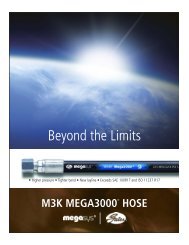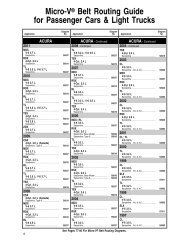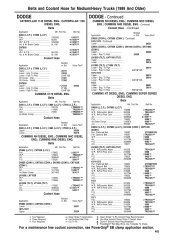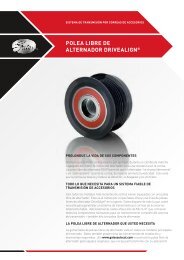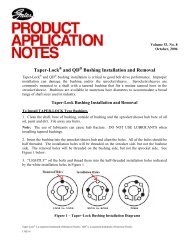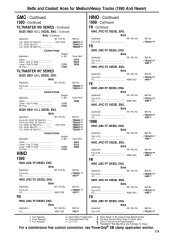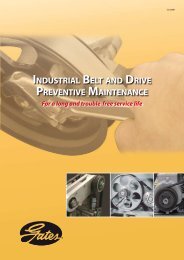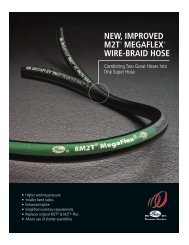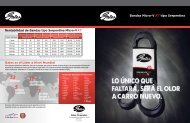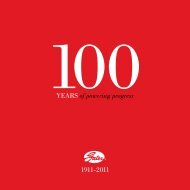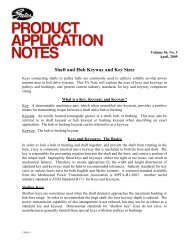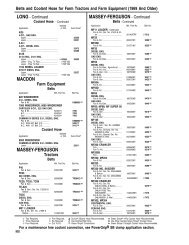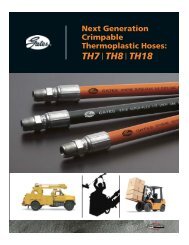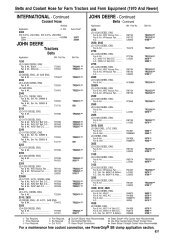PowerGrip® GT® Belt Drives
PowerGrip® GT® Belt Drives
PowerGrip® GT® Belt Drives
Create successful ePaper yourself
Turn your PDF publications into a flip-book with our unique Google optimized e-Paper software.
Polyflex ® JB ® and Micro-V ® <strong>Belt</strong> Drive Selection Procedures<br />
How to Design Polyflex JB and Micro-V <strong>Belt</strong> <strong>Drives</strong><br />
Note: The upcoming drive selection and<br />
engineering sections provide information for<br />
Polyflex JB and Micro-V belts and sheaves (or<br />
pulleys). Where we refer to sheaves (for Polyflex JB<br />
belts), you can substitute pulleys for Micro-V belts.<br />
If you need additional information, contact Gates<br />
Application Engineering, Denver.<br />
This section describes how to design standard twosheave<br />
Polyflex JB and Micro-V drives.<br />
To select either a Gates Polyflex JB and Micro-V<br />
<strong>Belt</strong> drive, you need to know these five facts:<br />
1. Horsepower or kilowatt rating of the driveR<br />
machine<br />
2. rpm of the driveR machine<br />
3. rpm of the driveN machine<br />
4. Approximate center distance required<br />
5. Hours per day operation.<br />
Follow these seven steps to design a drive:<br />
Step 1 Find the Design Horsepower (Design kw)<br />
Design Horsepower =<br />
(Service Factor) x (Horsepower Requirement)<br />
A. Select the proper service factor from Table 36<br />
on Page 73. If your driveN machine is not<br />
listed, find a machine with comparable starting,<br />
running and shock load characteristics.<br />
B. The horsepower requirement of the drive usually<br />
is taken as the nameplate rating of the driveR.<br />
The actual requirement of the driveN machine<br />
may be used as the horsepower requirement, if<br />
it is known. This type of load approximation is<br />
used in those applications where a small<br />
auxiliary machine is being driven from a large<br />
motor or engine.<br />
Step 2 Find the Speed Ratio<br />
Use Formula 8 below to calculate the desired speed<br />
ratio for your drive. The speed ratio can be<br />
determined from either the shaft speeds or the<br />
sheave pitch diameters. To determine the pitch<br />
diameter of a sheave, measure the outside diameter<br />
and add the appropriate add-on factor from Table<br />
32.<br />
Formula 8<br />
Speed =<br />
RPM of Faster Shaft Pitch Dia. of Larger Sheave<br />
Ratio RPM of Slower Shaft = Pitch Dia. of Smaller Sheave<br />
Step 3 Choose the Sheave Diameters<br />
Standard sheave diameters for Polyflex JB and<br />
Micro-V belts are listed in Tables 27 and 31 on<br />
Page 68 and 70.<br />
A. The drive can be designed around a known<br />
sheave diameter. For example, if you have one<br />
sheave available, or if a minimum or maximum<br />
sheave diameter is known, use Formula 8 in<br />
conjunction with Table 27 or Table 31 to<br />
determine the other sheave diameter. To<br />
calculate the pitch diameter of the larger sheave,<br />
multiply the pitch diameter of the smaller<br />
sheave by the speed ratio, or divide the pitch<br />
diameter of the smaller sheave. To convert the<br />
pitch diameter to outside diameters, subtract the<br />
values in Table 32 from the pitch diameters.<br />
Table 32 – Factors to Calculate Polyflex JB<br />
and Micro-V Pitch Diameters<br />
O.D. to P.D. Value<br />
Cross Section (in) (mm)<br />
5M Polyflex JB +0.050 +1.27<br />
J Micro-V +0.030 +0.76<br />
NOTE: Pitch diameters are always used in speed ratio<br />
calculations. If your drive uses an electric motor, the minimum<br />
selected sheave O.D. should be at least as large as the sheave<br />
outside diameters specified in Table 37 on Page 73.<br />
B. Calculate the sheave rim speed for your drive<br />
using Formula 9 below:<br />
Formula 9<br />
Sheave Rim (O.D. of either sheave) x (rpm of same sheave)<br />
=<br />
Speed (ft/min) 3.82*<br />
*This constant is derived from 12/π.<br />
For standard Polyflex JB and Micro-V sheaves the<br />
rim speeds should not exceed 6,500 feet per<br />
minute. If the rim speeds exceed this figure, special<br />
sheave materials and dynamic balancing are usually<br />
required. If possible, redesign the drive using<br />
smaller diameter sheaves so that the rim speed is<br />
between 4,000 and 6,000 fpm.<br />
C. When designing a drive, consider these factors:<br />
1. Advantages of Larger Diameter Sheaves:<br />
Cost Considerations:<br />
Since sheave diameter and rated horsepower per<br />
belt or rib are proportional, larger diameter<br />
drives will usually require fewer belts or ribs to<br />
transmit a specific load. This generally results in<br />
a more cost effective drive.<br />
Space Limitations:<br />
In addition to being more cost effective, large<br />
diameter sheaves will result in a “narrower”<br />
drive. Therefore, to minimize the sheave face<br />
width, select the largest diameter drive from the<br />
group of drives being considered.<br />
However, if there are space restrictions and<br />
larger diameter sheaves cannot be used,<br />
consider using a smaller diameter drive from the<br />
group of drives being considered. If the driveR is<br />
an electric motor, the smallest sheave must be at<br />
least as large as the Minimum Recommended<br />
Sheave O.D. specified in Table 37 on Page 73.<br />
Component Life:<br />
As sheave diameters are increased, the required<br />
drive tensions and shaft pulls are decreased. By<br />
lowering the forces on the bearings, belts and<br />
sheaves, component wear is reduced and<br />
component service life is extended.<br />
NOTE: On some lightly-loaded drives, the cost<br />
of the larger sheave (to obtain belt speed<br />
between 4,000 and 6,000 feet per minute) may<br />
result in a less economical drive. For high<br />
horsepower drives, it is usually best to check<br />
several designs for economics before making a<br />
final choice.<br />
D. If the drive requires an idler, refer to Table 42<br />
on Page 81 for recommended idler diameters.<br />
The World’s Most Trusted Name in <strong>Belt</strong>s, Hose & Hydraulics.<br />
71



